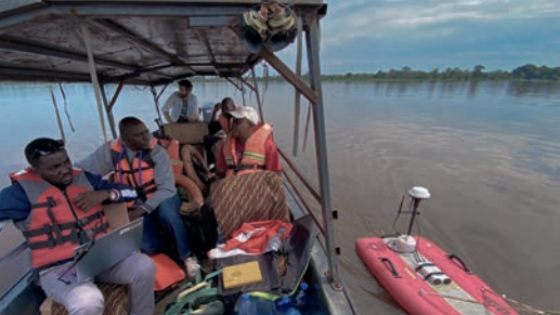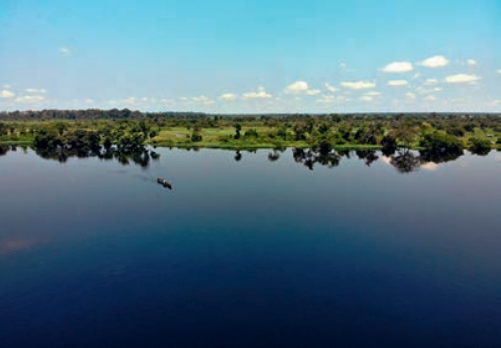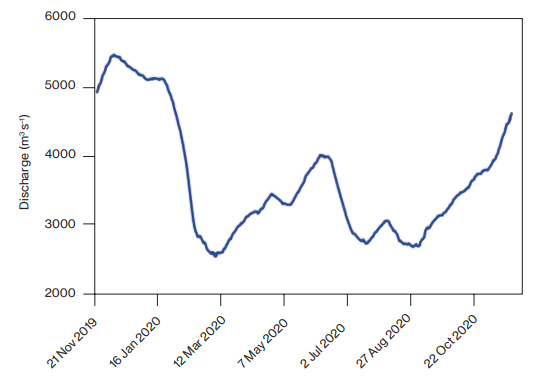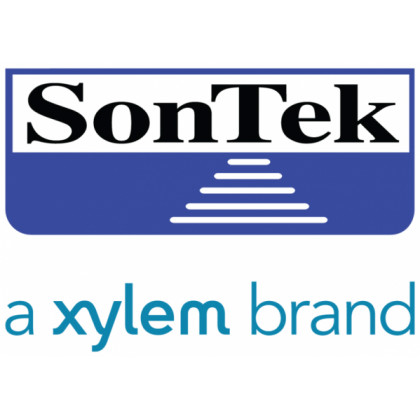

Annual Survey of Ruki River Uses ADCP to Help Gather Accurate Discharge Measurements
The Congo Basin holds the world’s second-largest tropical forest on Earth; a diverse landscape of montane forests, dense lowland forests, seasonally-inundated swamps, forest mosaics, and arid savannahs. Unfortunately, in the wake of the projected four-fold growth in human population, large regions within the Basin face dramatic increases in deforestation rates as forests are cleared for croplands, timber, settlements, and charcoal.
A new research project underway by the Sustainable Agroecosystems Group at the Swiss Federal Institute for Technology (ETH Zurich) aims to monitor the carbon biogeochemistry of a pristine river within the Congo Basin in order to establish a baseline against which to assess future human impacts.
The group selected the Ruki River, a large centrally-located tributary to the Congo. The Ruki represents only 5% of the total Congo Basin by area but is uniquely blanketed by homogenous pristine lowland forest land cover. Although the 5% basin footprint might seem small, it is still a massive river, draining an area 6 times the size of Belgium (188,800km2).
As a first step, the group set up a gauging station to continuously measure the discharge of the Ruki River 1km upstream of the RukiCongo confluence. At the gauging station, the river width is more than 500m and average flows are about 4500m3 s–1. Flow data generated by this gauging station was then used to quantify the fluvial export of carbon, nutrients, greenhouse gases, and sediment. Given the remote location, reliable instrumentation was required to measure the discharge of the Ruki.
An acoustic Doppler current profiler from SonTek (SonTek RiverSurveyor M9) in combination with the Torrent Board allowed us to easily conduct accurate discharge measurements. Ruki river discharge measurements commenced in November 2019 and were performed fortnightly until November 2020, in order to capture the entire hydrograph variability (Fig 1, next page).
Over the course of one year, 28 discharge measurements were conducted with the standard deviation of four transects (example transect Fig 2, next page) generally less than 1%. The RiverSurveyor M9 performed beautifully, despite the large width of the river, the slow-moving water, and the downstream drift due to the underpowered dugout canoe used to cross the river.

Drone image showing discharge measurement of the Ruki river using the SonTek acoustic doppler current profiler operated from a traditional dugout canoe. Photo: M. Barthel

Technician Matti Barthel navigating through floating islands and traditional dugout canoes during discharge measurement of the Congo main stem. Photo: T. Drake

Ruki river gauge height after final installation. Together with the discharge measurement, a rating curve had been established enabling future discharge measurements without the need for an ADCP. Photo: M. Barthel
To bridge the fortnightly gaps in the discharge measurements, the research team, consisting of ETH researcher Dr. Travis Drake, University of Ghent postdoctoral researcher Dr. Marjin Bauters, UC Louvain PhD student Simon Baumgartner, and technician Dr. Matti Barthel set up a river gauge height.
Together with the daily river gauge height measurements, a rating curve was established allowing future discharge measurements at the remote location. Setting up a 4m free standing gauge at peak discharge was quite a challenge. After the gauge fell over multiple times as a result of fast currents and large floating islands that knocked it over, a more protected area for installation was found. Accurate discharge measurements are the backbone of quantifying the lateral export of carbon, nutrients, and greenhouse gases through rivers and streams.
With the research efforts in the Congo Basin, the team is confident to close some current glaring knowledge gaps in one of the most understudied regions of the world. The SonTek ADCP is currently in Kinshasa, waiting for its next field endeavour.

Taking the SonTek ADCP to the point of measurement took the team deep into the swamp forest. Photo: M. Barthel

Hydrograph of the Ruki River 1km upstream from the Ruki-Congo confluence. Continuous discharge measurement in concert with concentration measurements will allow for the calculation of annual fluxes of dissolved organic carbon, dissolved inorganic carbon, nutrients etc.

Ruki River cross-sectional velocities 1 km upstream of the Congo-Ruki confluence.
Do you have questions about this case study?
Get in touch with SonTek, and they would be happy to answer any questions you have about pricing, suitability, availability, specs, etc.

Related products




![Do-Giant-Tortoises-Make-Good-Neighbors-1[1].jpg](https://cdn.geo-matching.com/vRMO2Edp.jpg?w=320&s=a6108b2726133ff723670b57bc54c812)



